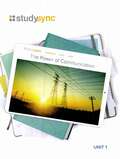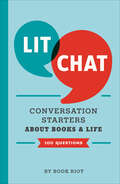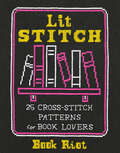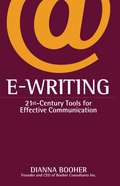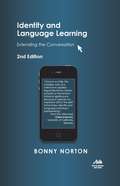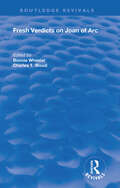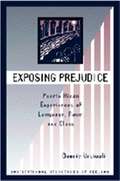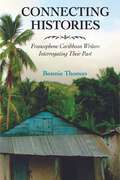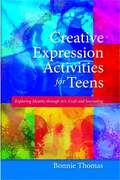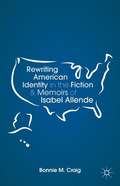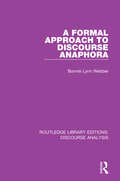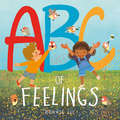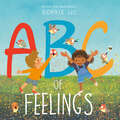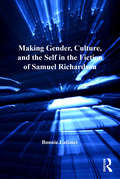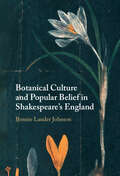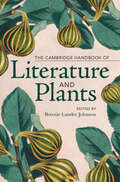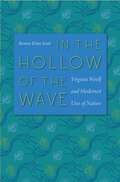- Table View
- List View
StudySync®, Reading & Writing Companion, Grade 6, Unit 1: Testing Our Limits
by BookheadEd LearningNIMAC-sourced textbook
StudySync Core ELA: Student Reading and Writing Companion Grade 10
by BookheadED LearningStudySync Core ELA Grade 10 Student Reading and Writing Companion
Lit Chat: Conversation Starters about Books and Life (100 Questions)
by Book RiotGet the conversation started—at your book club, writer&’s group, or any friendly get-together—with these 100 reading-themed questions. Some invoke books that are tied to memories (name your favorite childhood picture book); others prompt you to choose ideal reading material for a hypothetical situation (if you were stranded on a desert island, what book would you want with you?). Some of them aim to get people comparing their favorite (and not-so-favorite) characters or authors, and others engage in popular debates among readers (name a movie adaptation you liked and defend your choice). Created to give readers of all persuasions an excuse to talk about books, ideas, and life itself, this collection from the largest independent community for book lovers in North America is a delight for any bibliophile. Reading is a solitary experience—but being a reader is a shared experience, and that shared experience is what Lit Chat is all about.
Lit Stitch: 25 Cross-Stitch Patterns for Book Lovers
by Book Riot“Savvily combines literary themes and cross-stitch designs in [a] visually appealing collection of projects . . . delightful.” —Publishers Weekly Inside Book Riot’s Lit Stitch, you’ll find a number of badass, bookish cross-stitch patterns to let you show off your love of all things literary. Some are for bookmarks, others are for wall decor, and still others can take on a whole host of finished outcomes. What they have in common is their literary bent—the patterns speak to all manner of literary-minded book lovers, who are happy to display their nerdier sides. And what better way than through your own cross-stitch art to hang on your wall, prop on your desk, or even gift to friends and family? Most if not all are beginner-friendly and can be completed in a few hours—instant stitchification! So grab yourself some excellent embroidery floss, hoops, and needles, and pick out one or more of these great cross-stitch patterns for your next project.
E-Writing
by BooherAre you guilty of e-mail "trigger finger"? Do you constantly "cc" people you never even see? What are today's rules for conducting business over the Internet? Now, The Elements of Style meets "the Miss Manners of memos" in the ultimate writing guide for the digital age. In an era when written communication in the workplace is more crucial than ever, at a time when many professionals all but completely eschew face-to-face dealings, E-writing is poised to become the new bible of business writing. Accessible and inviting, this Web-savvy "how-to" book promises to transform anxious e-mail hacks and mediocre memo writers into eloquent electronic scribes in no time at all. Inside, you will learn how to: combat counterproductive e-mail habits write authoritatively and persuasively, with a clear message that generates quick action handle e-mail and letter correspondence efficiently and effectively select an appropriate style for the audience you're addressing heighten your professional image, self-confidence, and career prospects. Practicing what she preaches, award-winning communicator and bestselling author Dianna Booher writes in a refreshingly straightforward style and has organized E-writing to make on-the-spot referencing a snap. Keep it handy; refer to it often -- and your online mailbox will never be the same again.
Identity and Language Learning
by Bonny NortonIdentity and Language Learning draws on a longitudinal case study of immigrant women in Canada to develop new ideas about identity, investment, and imagined communities in the field of language learning and teaching. Bonny Norton demonstrates that a poststructuralist conception of identity as multiple, a site of struggle, and subject to change across time and place is highly productive for understanding language learning. Her sociological construct of investment is an important complement to psychological theories of motivation. The implications for teaching and teacher education are profound. Now including a new, comprehensive Introduction as well as an Afterword by Claire Kramsch, this second edition addresses the following central questions: Under what conditions do language learners speak, listen, read and write? How are relations of power implicated in the negotiation of identity? How can teachers address the investments and imagined identities of learners? The book integrates research, theory, and classroom practice, and is essential reading for students, teachers and researchers in the fields of language learning and teaching, TESOL, applied linguistics and literacy.
Fresh Verdicts on Joan of Arc
by Bonnie Wheeler and Charles T. WoodFirst published in 1996. This volume of original essays employs the latest tools of historical analysis, literary criticism, and feminist inquiry to reval why Joan of Arc was such an important figure.
Exposing Prejudice
by Bonnie UrciuoliPuerto Ricans in the United States, like other migrant minorities, face an array of linguistic judgments. They are told they don’t succeed because they don’t speak English. They are told their English is "impure” or "broken” because it has been "mixed” with Spanish. They are told that they sound inarticulate and that if they speak "correct” English, with no sign of Spanish influence-most particularly with no accent, they will get better jobs. In short, Puerto Ricans in the United States are told that the origins of their economic and social problems are linguistic and can be remedied through personal effort, when in fact their fundamental problems stem from racial and class exclusion. Concepts like "mixed” or "broken” languages, and "good” and "bad” English are cultural constructions and therefore are about more than language. In the Puerto Rican experience of devaluation and prejudice in the United States, the institutionalization of racial exclusion and class location are mapped onto English and Spanish in complex and highly politicized ways. Formal linguistic studies of bilingualism rarely engage this process in a significant way. But the place, function, and meaning of cultural constructs within the politicized communicative economy must be understood in terms of the intersections of race, class, and language that shape the lives of working-class Puerto Ricans. Working from ethnographic studies and interviews done on New York’s Lower East Side and in the Bronx, this book examines that intersection in detail.
Exposing Prejudice
by Bonnie UrciuoliPuerto Ricans in the United States, like other migrant minorities, face an array of linguistic judgments. They are told they don't succeed because they don't speak English. They are told their English is "impure" or "broken" because it has been "mixed" with Spanish. They are told that they sound inarticulate and that if they speak "correct" English, with no sign of Spanish influence-most particularly with no accent, they will get better jobs. In short, Puerto Ricans in the United States are told that the origins of their economic and social problems are linguistic and can be remedied through personal effort, when in fact their fundamental problems stem from racial and class exclusion.Concepts like "mixed" or "broken" languages, and "good" and "bad" English are cultural constructions and therefore are about more than language. In the Puerto Rican experience of devaluation and prejudice in the United States, the institutionalization of racial exclusion and class location are mapped onto English and Spanish in complex and highly politicized ways. Formal linguistic studies of bilingualism rarely engage this process in a significant way. But the place, function, and meaning of cultural constructs within the politicized communicative economy must be understood in terms of the intersections of race, class, and language that shape the lives of working-class Puerto Ricans. Working from ethnographic studies and interviews done on New York's Lower East Side and in the Bronx, this book examines that intersection in detail.
Exposing Prejudice
by Bonnie UrciuoliPuerto Ricans in the United States, like other migrant minorities, face an array of linguistic judgments. They are told they don't succeed because they don't speak English. They are told their English is "impure" or "broken" because it has been "mixed" with Spanish. They are told that they sound inarticulate and that if they speak "correct" English, with no sign of Spanish influence-most particularly with no accent, they will get better jobs. In short, Puerto Ricans in the United States are told that the origins of their economic and social problems are linguistic and can be remedied through personal effort, when in fact their fundamental problems stem from racial and class exclusion.Concepts like "mixed" or "broken" languages, and "good" and "bad" English are cultural constructions and therefore are about more than language. In the Puerto Rican experience of devaluation and prejudice in the United States, the institutionalization of racial exclusion and class location are mapped onto English and Spanish in complex and highly politicized ways. Formal linguistic studies of bilingualism rarely engage this process in a significant way. But the place, function, and meaning of cultural constructs within the politicized communicative economy must be understood in terms of the intersections of race, class, and language that shape the lives of working-class Puerto Ricans. Working from ethnographic studies and interviews done on New York's Lower East Side and in the Bronx, this book examines that intersection in detail.
Connecting Histories: Francophone Caribbean Writers Interrogating Their Past (Caribbean Studies Series)
by Bonnie ThomasThe Francophone Caribbean boasts a trove of literary gems. Distinguished by innovative, elegant writing and thought-provoking questions of history and identity, this exciting body of work demands scholarly attention. Its authors treat the traumatic legacies of shared and personal histories pervading Caribbean experience in striking ways, delineating a path towards reconciliation and healing. The creation of diverse personal narratives—encompassing autobiography, autofiction (heavily autobiographical fiction), travel writing, and reflective essay—remains characteristic of many Caribbean writers and offers poignant illustrations of the complex interchange between shared and personal pasts and how they affect individual lives. Through their historically informed autobiography, the authors in this study—Maryse Condé, Gisèle Pineau, Patrick Chamoiseau, Edwidge Danticat, and Dany Laferrière—offer compelling insights into confronting, coming to terms with, and reconciling their past. The employment of personal narratives as the vehicle to carry out this investigation points to a tension evident in these writers’ reflections, which constantly move between the collective and the personal. As an inescapably complex network, their past extends beyond the notion of a single, private life. These contemporary authors from Martinique, Guadeloupe, and Haiti intertwine their personal memories with reflections on the histories of their homelands and on the European and North American countries they adopt through choice or necessity. They reveal a multitude of deep connections that illuminate distinct Francophone Caribbean experiences.
Creative Expression Activities for Teens
by Bonnie ThomasCoping with life's stresses is difficult for everybody, but can be especially challenging for teenagers, who often feel isolated and misunderstood. Creative expression through art, craft, and writing is a natural and effective way of helping young people to explore and communicate personal identity. This book is bursting with art and journal activities, creative challenges, and miniature projects for bedrooms and other personal spaces, all of which help teenagers to understand and express who they are and what is important to them. These fun ideas can be tailored to suit the individual, and require minimal equipment and even less artistic know-how, so can be enjoyed by all. The book concludes with a useful section for counselors and other professionals who work with young people, which explains how these activities can be incorporated into treatment goals. This imaginative and insightful book is a useful resource for all therapists, social workers, and counselors who wish to encourage self-expression in teenagers.
Rewriting American Identity in the Fiction and Memoirs of Isabel Allende
by Bonnie M. CraigMoving away from territorially-bound narratives toward a more kinetic conceptualization of identity, this book represents the first analysis of the politics of American identity within the fiction and memoirs of Isabel Allende. Craig offers a radical transformation of societal frameworks through revised notions of place, temporality, and space.
A Formal Approach to Discourse Anaphora (RLE: Discourse Analysis)
by Bonnie Lynn WebberFirst published in 1979, this book starts from the perspective that dealing with anaphoric language can be decomposed into two complementary tasks: 1. identifying what a text potentially makes available for anaphoric reference and 2. constraining the candidate set of a given anaphoric expression down to one possible choice. The author argues there is an intimate connection between formal sentential analysis and the synthesis of an appropriate conceptual model of the discourse. Some of the issues with the creation of this conceptual model are discussed in the second chapter, which follows a background to the thesis that catalogues the types of anaphoric expression available in English and lists the types of things that can be referred to anaphorically. The third and fourth chapters examine two types of anaphoric expression that do not refer to non-linguistic entities. The final chapter details three areas into which this research could potentially be extended. This book will be of interest to students of linguistics.
ABC of Feelings
by Bonnie LuiFrom Anxious to Zany, kids have a wide range of emotions . . . Explore them all through the ABC of Feelings! Featuring a charming cast of diverse characters, bright and soulful artwork, and clear descriptions for a whole alphabet of different feelings—like brave, embarrassed, grateful, lonely, and overwhelmed—this first book of emotions gives young readers the vocabulary they need to start discussing how they feel. Author-illustrator Bonnie Lui, a Dreamworks animator by day and children's book creator by night, has a true knack for storytelling and for showing children that it's OK to feel something other than "happy."
ABC of Feelings
by Bonnie LuiThe perfect way for kids to explore the wide range of emotions they feel every day--complete from A to Z with bright, bold illustrations!From anxious to zany, kids experience a wide range of emotions, but they don't often have the language to explain how they're feeling. ABC of Feelings explains that it's perfectly okay--and normal!--to feel many different things, and gives both kids and parents the tools they need to make the abstract nature of feelings and emotions easier to discuss and understand.
Making Gender, Culture, and the Self in the Fiction of Samuel Richardson: The Novel Individual (British Literature in Context in the Long Eighteenth Century)
by Bonnie LatimerProposing that Samuel Richardson's novels were crucial for the construction of female individuality in the mid-eighteenth century, Bonnie Latimer shows that Richardson's heroines are uniquely conceived as individuals who embody the agency and self-determination implied by that term. In addition to placing Richardson within the context of his own culture, recouping for contemporary readers the influence of Grandison on later writers, including Maria Edgeworth, Sarah Scott, and Mary Wollstonecraft, is central to her study. Latimer argues that Grandison has been unfairly marginalised in favor of Clarissa and Pamela, and suggests that a rigorous rereading of the novel not only provides a basis for reassessing significant aspects of Richardson's fictional oeuvre, but also has implications for fresh thinking about the eighteenth-century novel. Latimer's study is not a specialist study of Grandison but rather a reconsideration of Richardson's novelistic canon that places Grandison at its centre as Richardson's final word on his re-envisioning of the gendered self.
Botanical Culture and Popular Belief in Shakespeare's England
by Bonnie Lander JohnsonThe Shakespearean stage offered London playgoers a glimpse of the illiterate and rural plant cultures rapidly disappearing from their increasingly urban and sophisticated lives. The same cultures also circulated in popular texts offstage: bawdy tree ballads, botanical tales, almanacs and accounts of kitchen physic. Here Bonnie Lander Johnson argues that, while Shakespeare's plants offered audiences a nostalgic vision of childhood, domestic education and rural pastimes, this was in fact done with an ironic gesture that claimed for illiterate culture an intellectual relevance ignored by the learned and largely Protestant realm of print. Addressing a long-standing imbalance in early modern scholarship, she reveals how Shakespeare's plays – and the popular, low botanical beliefs they represent – engaged with questions usually deemed high, literate and elite: theological and liturgical controversies, the politics of state, England's role in Elizabethan naval conflict and the increasingly learned realm of medical authority.
Chastity in Early Stuart Literature and Culture
by Bonnie Lander JohnsonIn this book, Bonnie Lander Johnson explores early modern ideas of chastity, demonstrating how crucial early Stuart thinking on chastity was to political, medical, theological and moral debates, and that it was also a virtue that governed the construction of different literary genres. Drawing on a range of materials, from prose to theatre, theological controversy to legal trials, and court ceremonies - including royal birthing rituals - Lander Johnson unearths previously unrecognised opinions about chastity. She reveals that early Stuart theatrical and court ceremonies were part of the same political debate as prose pamphlets and religious sermons. The volume also offers new readings of Milton's Comus, Shakespeare's The Winter's Tale, Henrietta Maria's queenship and John Ford's plays. It will appeal to scholars of early modern literature, theatre, political, medical and cultural history, and gender studies.
The Cambridge Handbook of Literature and Plants
by Bonnie Lander JohnsonThe first of its kind, this wide-ranging, accessible handbook covers literary engagement with plants in over two thousand years of writing from around the world. It includes within its broad ambit historical periods of Latin, Norse and Anglophone plant literatures, prominent plant genres, and the literatures of major global regions. Chapters explore the history of literary thinking about plants as creatures that do or do not resemble us; our use of plants to negotiate geo-political conflict; the ethical dimension of plant sensibilities; the moral dimension of our desire to engage aesthetically with plants; the ways in which human-plant relations have been used to make and unmake national and ethnic identities; the role of plant-writing in the development of literary form; and the ways we have used plants to navigate modernity's cultural and intellectual shift from theological engagement with the created world to the discourses of modern science.
Basic English Composition
by Bonnie L. WalkerHelp students to build a strong vocabulary foundation and develop a full understanding of the English language.
Basic English Grammar
by Bonnie L. WalkerThis comprehensive text builds and reinforces basic language skills. The high-interest, easy-reading lessons keep students involved as they learn parts of speech and sentence construction. Frequent examples throughout the text help students see the relevance of learning grammar.
Life Skills English
by Bonnie L. WalkerIn this book, you will learn what kinds of print resources are available to you and where to find them. You will learn the kinds of information each resource contains and how that information is arranged. Then you will be able to find the information you need quickly.
Life Skills English
by Bonnie L. WalkerLife Skills English sharpens the language skills that young people need today. This book is based on feedback from around the country, and teaches how to find information, how information is organized, and how to use reference tools & vital skills for today's students.
In the Hollow of the Wave: Virginia Woolf and Modernist Uses of Nature
by Bonnie Kime ScottExamining the writings and life of Virginia Woolf, In the Hollow of the Wave looks at how Woolf treated "nature" as a deliberate discourse that shaped her way of thinking about the self and the environment and her strategies for challenging the imbalances of power in her own culture—all of which remain valuable in the framing of our discourse about nature today. Bonnie Kime Scott explores Woolf’s uses of nature, including her satire of scientific professionals and amateurs, her parodies of the imperial conquest of land, her representations of flora and fauna, her application of post-impressionist and modernist modes, her merging of characters with the environment, and her ventures across the species barrier.In shedding light on this discourse of Woolf and the natural world, Scott brings to our attention a critical, neglected, and contested aspect of modernism itself. She relies on feminist, ecofeminist, and postcolonial theory in the process, drawing also on the relatively recent field of animal studies. By focusing on multiple registers of Woolf’s uses of nature, the author paves the way for more extended research in modernist practices, natural history, garden and landscape studies, and lesbian/queer studies.

